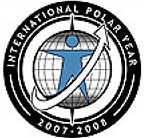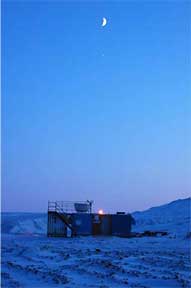Arctic Research
NOAA studies underway in the Arctic will lead to a better understanding of how the Arctic influences global weather and climate and achieve greater insights into the climate our children will inherit.
International Polar Year

On three occasions over the past 125 years scientists from around the world banded together to organize concentrated scientific and exploring programs in the polar regions. During International Polar Year (IPY) 2007-2008, NOAA and its research partners will expand upon this legacy of scientific achievement and societal benefits. Extreme changes are occurring in the Arctic region and those changes influence the rest of the global climate system. The sensitivity and complexity of the Arctic underline the necessity of expanded Arctic observations as part of IPY 2007-2008.
More information on IPY is available here: http://www.ipy.noaa.gov/.
NOAA Research Partnerships Enhance Global Climate Observation System

NOAA Atmospheric Observatory in Eureka, Canada. Von Walden
NOAA’s Earth System Research Lab, in conjunction with the Canadian Network for Detection of Arctic Change program, and the Meteorological Service of Canada established a research site located in Eureka, Nunavut on Ellesmere Island, to make longterm climate measurements of Arctic clouds and aerosols. Collected data will aid development of mitigation and adaptation strategies in the Arctic and throughout the global climate system. A collection of state-of-the-art scientific equipment has been assembled at the site, including cloud radar, high spectral resolution lidar and spectral and narrowband radiometers. This observatory supports NOAA’s activities for the 2007 International Polar Year.
State of the Arctic Report
In October 2006, NOAA’s Pacific Marine Environmental Laboratory released a State of the Arctic Report, a review of environmental conditions during the past five years relative to those earlier in the 20th century. The Report updates some of the records from the Arctic Climate Impact Assessment released in November 2004, and is available on-line at: http://www.pmel.noaa.gov/pubs/PDF/rich295 2/rich2952.pdf.
Collectively, the observations presented in the Report show convincing evidence of a sustained period of warming in the Arctic, including a continued reduction in sea ice extent, observed at both the winter maximum and summer minimum, and widespread changes in Arctic vegetation. The overall warming trends are resulting in complex and difficult to predict shifts in Arctic vegetation, land temperature patterns, ocean salinity and temperature, sea-ice thickness/ extent and permafrost distributions.
PREEMINENT RESEARCH
Arctic Atmospheric Observatories: NOAA Research is establishing Arctic observatories in key locations to make continuous, measurements of Arctic surface radiation, clouds, aerosols, and chemistry sufficient for detailed evaluation of interactive climate change processes in the lower Arctic atmosphere. Existing observatories include Barrow, Alaska (http://www.cmdl.noaa.gov/obop/brw/), and Eureka, Nunavut, established in 2006 at an existing Canadian meteorology station.
Russian-American Long-term Census of the Arctic (RUSALCA): The Bering/Chukchi Seas region is thought to be particularly sensitive to global climate change because of the anticipated loss of winter ice cover and the warming of ocean waters. To understand the impact of exchanges between the Arctic and the Pacific oceans, it is necessary to monitor the changes of water, heat, salt and nutrients, as well as the resulting redistribution and migration of plants and animals. Collaboration between the U.S. and Russia began with the expedition of the Bering and Chukchi Seas ( Arctic Ocean ) in 2004, and continues under an agreement between the two countries known as the Russian-American Longterm Census of the Arctic (RUSALCA) (Rusalca means mermaid in the Russian language.) (http://www.arctic.noaa.gov/aro/russian-american/).
Arctic Change Detection: NOAA and its research partners analyze historical and ongoing Arctic changes to assess and predict Arctic change. For instance, an analysis of trends over the past 34 years for a large number of environmental variables indicate far-reaching and correlated changes across a wide variety of physical and biological indicators. (http://www.arctic.noaa.gov/detect/)
Arctic Ocean Ice Thickness Buoys: One of the most dramatic and visible changes to the Arctic system is the decreasing extent and thickness of Arctic Ocean ice. Monitoring ice thickness is challenging (http://www.crrel.usace.army.mil/sid/IMB/). NOAA contributes to an ice buoy network, the primary source of these data.
Study of Environmental Arctic Change (SEARCH): NOAA's Arctic research supports a number of projects focused on SEARCH http://www.arctic.noaa.gov/search/, an interagency program, fostering cooperation so that the full scope of changes in the Arctic can be fully understood and described.
VALUE TO SOCIETY
The Arctic has changed over the last 30 years. Some of the clearest indicators of this change are the warming of spring temperatures in Alaska, the warming of winter temperatures in Northern Europe, the loss of sea ice area in the central Arctic, and the conversion of tundra to wetlands and shrub lands in East Siberia, Northwest Canada and Alaska. These changes in physical conditions also impact marine and terrestrial ecosystems. Changes over the last decade have been major and unprecedented. These changes include unusual melting of glaciers, sea ice, and permafrost; shifts in patterns of rain and snow fall, freshwater runoff, and forest/tundra growth; and disrupted wildlife migration patterns, altered fish stocks, modified agricultural zones, and increased forest fires. These changes impact the lives of Native residents who depend on the environment as part of their traditional subsistence lifestyle, and may also have significant impacts on the oil industry, tourism, and shipping routes.
To Learn More, Visit These Sites:
Up-to-date status of the Arctic environment is available from NOAA's
new Near-real-time Arctic Change Indicator website, which provides information
on the present state of Arctic ecosystems and climate in a historical context,
with easy to read and understand narratives http://www.arctic.noaa.gov/data.html.
NOAA collaborates with several groups on Arctic research, both domestically
and internationally, including:
The Arctic Monitoring and Assessment Programme
(AMAP) http://www.amap.no/
The Arctic Council http://www.arctic-council.org/
The Cooperative Institute
for Arctic Research http://www.cifar.uaf.edu/
The International Arctic Research
Center http://www.iarc.uaf.edu/
To Work or Study at OAR, Visit These Sites:
NOAA Careers: http://www.careers.noaa.gov
Hollings Scholarships:
http://www.orau.gov/noaa/HollingsScholarship/
Knauss Fellowships: http://www.seagrant.noaa.gov/knauss/
April 2007

